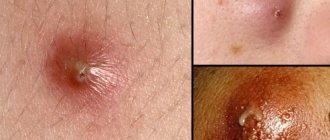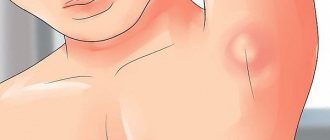Redness of the scrotum may be a sign of some dangerous disease that requires timely diagnosis and treatment. In fact, there may be many reasons for the occurrence of this symptom, but self-medication is in any case unacceptable. You should contact a medical professional, regardless of your age and even if there are no other symptoms other than this.
The doctor will prescribe the necessary diagnostic examination to determine the exact cause of the redness. If you delay this, the disease will be advanced and, accordingly, it will be more difficult to treat. For example, sometimes redness is not at all associated with irritation, and sometimes it’s the other way around. The results of the examinations will help the doctor make an accurate determination, and based on this, the correct therapeutic course will be prescribed.
Causes
Pigmentation in the scrotum area has different colors and patterns of manifestation. The spots are white, red and bluish. They may be flat or protrude above the skin. Some formations do not bother the patient at all, others are accompanied by itching in the groin, pain and burning.
The reasons for the appearance of pigmentation are different:
- Allergic reaction. Red spots on the testicles indicate adverse reactions of the body. They arise due to the body's intolerance to certain foods, detergents, and intimate lubricants. Allergies occur due to poor quality clothing and tight underwear. As a rule, pathology does not appear immediately, but some time after contact with the pathogen. The allergy is accompanied by redness of the skin, the appearance of spots on the scrotum, itching, and irritation. Over time, the spots begin to protrude above the skin, burst and form weeping ulcers.
- Fungal infections in the groin. The fungus, a photo of which can be seen on medical sources, occurs due to improper hygiene, close contact with a carrier of the infection, and the use of other people's personal belongings. The pathology manifests itself in the form of excessive pigmentation on the testicles, the appearance of an unpleasant odor from the intimate area, and also white discharge. In advanced cases, the patient develops a white coating in the problem area.
- Herpes. Genital herpes appears directly after unprotected sexual contact with a carrier of the infection. However, contraception also does not provide complete protection, and the disease may appear when using it. Genital herpes does not show itself immediately, but after an incubation period. The patient may observe pink and red formations on the scrotum, which have a rough structure. The pathology is also accompanied by severe itching, swelling, and pain. A man experiences problems with sex life and going to the toilet. Herpes is difficult to treat, so it is important to recognize it in the early stages of development. This will help prevent relapses.
Why else do they appear?
- STD. Purple spots on the eggs and purulent pimples are a sign of sexually transmitted infections. They appear with frequent changes of partners and neglect of contraception. Genital infections are accompanied by itching, yellow and white discharge, as well as an unpleasant odor from the intimate area.
- Pediculosis. Pubic lice appear as a result of contact with a carrier of the pathology, as well as after using other people's hygiene products. As the disease progresses, the patient experiences itching in the scrotum area, red spots form as if from abrasions, which itch and swell. Painful sensations interfere with going to the toilet and leading a healthy sex life.
- Hormonal disbalance. Improper functioning of the body, a lack or excess of certain hormones leads to the appearance of spots on and near the testicles, which cause aesthetic discomfort. In such cases, the patient experiences mild symptoms of the disease. Problems with hormones lead to erection problems. Such diseases are more common in boys during adolescence.
- Poor hygiene. Neglecting water procedures or using harmful detergents leads to the development of pigmentation on the skin. This is how the patient develops dermatitis on the testicles. In such cases, it is enough to change the approach to caring for your body and start using hypoallergenic products for washing.
- Angiokeratoma. Black spots can be moles and age spots that appear at birth or throughout life. Angiokeratoma also occurs in case of mechanical trauma, for example, during shaving or rough sexual intercourse. The dark formation does not threaten the patient’s life, but requires regular checks by a doctor.
Normal and dangerous symptoms
Normally, the points on the scrotum do not hurt, do not itch, or become inflamed. They should disappear 3-7 days after they appear. White pimples on the balls of a teenager disappear when a period of hormonal changes passes.
Dangerous symptoms requiring consultation with a dermatologist:
- spread of white dots from the scrotum to the penis, testicles;
- increased body temperature;
- discharge of pus;
- development of lymphangitis, lymphadenitis;
- maturation of white formations, appearance of ulcers, wound defects;
- swelling of the scrotum;
- a sharp increase in the size of the dots, a change in their shape;
- the course of the disease for more than 10 days.
These conditions indicate a bacterial infection or the development of dangerous complications.
In children
A spot on a child’s testicle indicates an allergy and fungal infection. In infants, the disease develops due to allergies.
What pathologies do white spots on the testicles indicate:
- HPV;
- problems with the thyroid gland and hormones;
- lipoma;
- wart;
- cyst.
White pigmentation is most often accompanied by itching and discomfort when walking or going to the toilet.
In cases of a wen or cyst, the formations gradually increase in size, begin to protrude above the skin and cause severe discomfort to the man. In such cases, urgent medical intervention is required.
Pimple Treatment Methods
Treatment of white spots and dots on the skin of the scrotum involves therapeutic and preventive actions. The patient must remove factors that provoke skin irritation.
Therapy begins with replacing synthetic underwear with cotton. A man should go on a diet that limits the consumption of sweets, fatty, smoked, and salty foods.
Need advice from an experienced doctor?
Get a doctor's consultation online. Ask your question right now.
Ask a free question
The scrotum, penis, testicles with points are washed with warm water without soap with the addition of herbal infusions. During the period of treatment of white formations, it is necessary to avoid sexual contact, so as not to infect the partner, and to avoid the addition of a secondary infection.
Basic treatment measures
| Pathological condition | Treatment |
| Bacterial infection | Antimicrobial, disinfectants for external and internal use. Amoxicillin, Azithromycin tablets, ointments based on Streptomycin, Erythromycin. |
| Herpes | Acyclovir in ointments and tablets. |
| Syphilis | Medicines that suppress the reproduction of treponemas. |
| Condylomas acuminata | Surgical or laser destruction of the white rash, immunomodulatory and antiviral therapy to avoid relapse. |
| Allergic reactions, dermatitis | Antihistamines, antiseptics. Severe cases are treated with corticosteroids. |
| Fungal infection | Antimycotic ointments, tablets of Clotrimazole, Fluconazole, Difluzol help against white fungal spots. |
| Molluscum contagiosum | Medicines to enhance immunity. External manifestations of the disease on the scrotum are removed with a laser or scalpel under local anesthesia. |
| Boils, carbuncles, benign formations, cysts | Surgical method. To improve the patient's condition - drugs to relieve pain and intoxication syndromes. |
Timely treatment ensures quick relief from scrotal pathology and prevention of complications of the condition.
Diagnosis and treatment
To clarify the situation, it is recommended to consult a urologist, venereologist or surgeon. If in doubt, you should visit a therapist. He will conduct an examination, make his assumptions and refer you to the right specialist.
To clarify the diagnosis, the following studies are carried out:
- smear for infections;
- general and biochemical blood test;
- hormonal studies;
- Ultrasound of the groin area;
- puncture (if a malignancy is suspected).
After the test results, treatment is prescribed. It is based on taking the following medications:
- antibiotics;
- anti-inflammatory drugs;
- antimycotic drugs;
- immunostimulating products;
- antifungal agents;
- antihistamine ointments;
- antiseptic solutions.
What is it, how does it manifest itself and why does it happen?
Epididymitis is an inflammation of the epididymis. Orchitis is inflammation of the testicle itself, and orchiepididymitis is simultaneous inflammation of the testicle and its epididymis. The testicle, epididymis and spermatic cord are also called the scrotal organs. In practice, epididymitis is most often observed, less often orchiepididymitis and even less often isolated orchitis. Also quite rare is isolated inflammation of the vas deferens, which is part of the spermatic cord - deferentitis . These inflammatory processes can be acute, chronic and recurrent.
Acute epididymitis, orchiepididymitis or orchitis is a sudden inflammation, accompanied by enlargement and hardening of the testicle and/or its epididymis, sharp and intense pain and a rise in body temperature. With proper treatment, these diseases disappear within 2 weeks.
Chronic inflammation of the testicle and/or epididymis is characterized by a long-term (from several months to several years) course and resistance to treatment. Tuberculous epididymitis most often has a chronic course. Recurrent inflammation of the scrotal organs is associated with inadequate treatment or repeated infection in the epididymis and testicle. Chronic and recurrent epididymitis, orchiepididymitis and orchitis are manifested by a less pronounced increase and more local compaction of the scrotal organs, the pain is less intense and paroxysmal in nature, body temperature is usually normal.
The causes of these inflammatory processes are most often infections that enter the epididymis through the vas deferens from the urethra (urethra). Moreover, in young men under 35 years of age, these are most often sexually transmitted infections. In particular, chlamydia is the cause of acute epididymitis in young men with a frequency of more than 50%. At older ages (after 50 years), the leading cause of inflammation of the scrotal organs is intestinal microorganisms that cause urinary tract infections (cystitis, pyelonephritis). These include Escherichia coli, Klebsiella, Enterococcus, Pseudomonas, Proteus, etc. Less commonly, the cause of epididymitis and orchitis, as well as deferentitis, can be a tuberculosis or viral infection. Thus, in boys under 15 years of age, orchitis can often become a complication of viral mumps (mumps) or rubella. The development of epididymitis, orchitis and orchiepididymitis is greatly facilitated by sudden hypothermia, which leads to a deterioration in the blood supply to the scrotum. Inflammation of the scrotal organs can also be caused by injuries and operations on the testicle, its epididymis and spermatic cord. In this regard, after injuries to the scrotum and operations on its organs, antibiotics and anti-inflammatory drugs are often prescribed.
Complications
Failure to provide timely assistance for testicular torsion leads to serious blood flow disorders.
First, the venous link suffers, and then the arterial link, which disrupts the nutrition of the organ, which is fraught with the development of necrosis. The severity and nature of complications depend on the time and number of twists. Hemorrhages and ischemic tissue due to traumatic injuries to the scrotal organs are a good breeding ground for bacteria. Therefore, in order to prevent the development of inflammatory complications, you should contact a pediatric urologist surgeon as soon as possible after injury.
Thus, acute scrotum syndrome, in addition to systemic changes in the body, is dangerous due to damage to the testicle, which plays one of the main roles in the male body.










